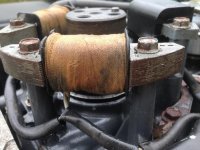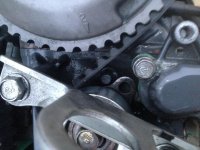Hi all, great forum here and here's my first post. I have done some searches here and they have been helpful but I'm looking for more info. Anyways, I have a SeaCat 21ft CC with twin 2002 Honda 50-hp outboards (carb'd) and both engines had work done over the winter (carbs, head gaskets) by a certified honda mechanic. The starboard engine has developed some problems recently and I need some help it diagnosing the latest issue. First the engine developed an oil leak from the crankshaft seal on top of the powerhead (underneath fly wheel), which was replaced by the mechanic. It ran well for 2 trips and then the engine quit on me over the weekend at the ramp. It started up fine but then shut off suddenly. The voltage on the gauge dropped very low so I tried jumping the engine thinking the battery was toast. The engine ran for a little bit after being jumped but then started making a ticking noise before shutting off. This week I did some trouble shooting, and I thought I had an electrical problem so first I swapped a new battery in but the engine wouldn't turn over. The starter gear would engage the fly wheel but it couldn't turn it. Anyways, I wasn't sure if it was a bad starter, but I suspected that the fly wheel might be stuck (after readying some threads on here). So I got out a pull cord and tried turning the fly wheel manually but it wouldn't budge. I checked the other engine and I could pull the fly wheel fairly easily.
Anyways, it seems that the fly wheel might be getting stuck, and I'm trying to figure out why. I thought initially that I had electrical problems due to a bad rectifier or stator, and I read a thread on here regarding a bad rectifier where one of the members mentioned that the coils can delaminate and impinge on the fly wheel locking it up. I noticed a couple metal shavings so it could be that but I'm not sure if its from that or leftover from the oil seal replacement. I can rotate the fly wheel back slightly so it's not completely stuck. My other fear is that because these are interference engines that maybe the timing slipped and the valves are hitting the pistons. I checked the belt tensions and the its a little looser on this engine than the good (port) engine, but not sure if it would be enough to make a difference. Its hard to say whether the timing marks between pulser and fly wheel are lined up correctly but there seems to be a small difference between each engine....not sure if its real or not at this point.
So I'm looking for input on what diagnostics I should perform next.
1) I have a spare starter that I can swap in, but not sure if it will matter since I cannot pull the fly wheel with the rope. Is it worth trying to jump the engine again or is that too risky?
2) Should I just go ahead and pop the fly wheel and if so are there any special tools that I need? Such as something to hold the fly wheel steady such as a simple strap wrench? I actually have a parts engine with a fly wheel and stator coils.
3) Is there anything I can do to check timing or if valves are hitting pistons? Maybe scope the spark plug holes?
Any other input is appreciated!
Anyways, it seems that the fly wheel might be getting stuck, and I'm trying to figure out why. I thought initially that I had electrical problems due to a bad rectifier or stator, and I read a thread on here regarding a bad rectifier where one of the members mentioned that the coils can delaminate and impinge on the fly wheel locking it up. I noticed a couple metal shavings so it could be that but I'm not sure if its from that or leftover from the oil seal replacement. I can rotate the fly wheel back slightly so it's not completely stuck. My other fear is that because these are interference engines that maybe the timing slipped and the valves are hitting the pistons. I checked the belt tensions and the its a little looser on this engine than the good (port) engine, but not sure if it would be enough to make a difference. Its hard to say whether the timing marks between pulser and fly wheel are lined up correctly but there seems to be a small difference between each engine....not sure if its real or not at this point.
So I'm looking for input on what diagnostics I should perform next.
1) I have a spare starter that I can swap in, but not sure if it will matter since I cannot pull the fly wheel with the rope. Is it worth trying to jump the engine again or is that too risky?
2) Should I just go ahead and pop the fly wheel and if so are there any special tools that I need? Such as something to hold the fly wheel steady such as a simple strap wrench? I actually have a parts engine with a fly wheel and stator coils.
3) Is there anything I can do to check timing or if valves are hitting pistons? Maybe scope the spark plug holes?
Any other input is appreciated!




